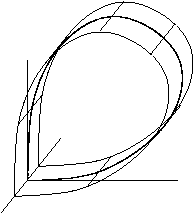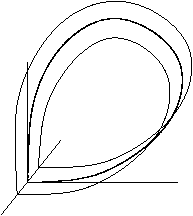Generalized quadrangle: Difference between revisions
en>Wcherowi m fixed caption |
en>Addbot m Bot: Migrating 1 interwiki links, now provided by Wikidata on d:q2754558 |
||
| Line 1: | Line 1: | ||
[[Image:homoclinic.svg|200px|thumb|right|A homoclinic orbit]] | |||
[[Image:oriented.png|200px|thumb|right|An oriented homoclinic orbit]] | |||
[[Image:mobius.png|200px|thumb|right|A twisted homoclinic orbit]] | |||
In [[mathematics]], a '''homoclinic orbit''' is a trajectory of a [[flow (mathematics)|flow]] of a [[dynamical system]] which joins a saddle equilibrium point to itself. More precisely, a homoclinic orbit lies in the intersection of the [[stable manifold]] and the [[unstable manifold]] of an [[equilibrium point|equilibrium]]. | |||
Consider the continuous dynamical system described by the ODE | |||
:<math>\dot x=f(x)</math> | |||
Suppose there is an equilibrium at <math>x=x_0</math>, then a solution <math>\Phi(t)</math> is a homoclinic orbit if | |||
:<math>\Phi(t)\rightarrow x_0\quad \mathrm{as}\quad | |||
t\rightarrow\pm\infty</math> | |||
If the [[phase space]] has three or more dimensions, then it is important to consider the [[topology]] of the unstable manifold of the saddle point. The figures show two cases. First, when the unstable manifold is topologically a cylinder, and secondly, when the unstable manifold is topologically a [[Möbius strip]]; in this case the homoclinic orbit is called ''twisted''. | |||
== Discrete dynamical system == | |||
Homoclinic orbits and '''homoclinic points''' are defined in the same way for [[iterated function]]s, as the intersection of the [[stable set]] and [[unstable set]] of some [[Fixed point (mathematics)|fixed point]] or [[periodic point]] of the system. | |||
We also have the notion of homoclinic orbit when considering discrete dynamical systems. In such a case, if <math>f:M\rightarrow M</math> is a [[diffeomorphism]] of a [[manifold]] <math>M</math>, we say that <math>x</math> is a homoclinic point if it has the same past and future - more specifically, if it exists a fixed (or periodic) point | |||
<math>p</math> such that | |||
:<math>\lim_{n\rightarrow \pm\infty}f^n(x)=p.</math> | |||
== Properties == | |||
The existence of one homoclinic point implies the existence of infinite number of them.<ref>{{cite book|last=Ott|first=Edward|title=Chaos in Dynamical Systems|year=1994|publisher=Cambridge University Press}}</ref> | |||
This comes from its definition: the intersection of a stable and unstable set. Both sets are [[Positive invariant set|invariant]] by definition, which means that the forward iteration of the homoclinic point is both on the stable and unstable set. By iterating N times, the map approaches the equilibrium point by the stable set, but in every iteration it is on the unstable manifold too, which shows this property. | |||
This property suggests that complicated dynamics arise by the existence of a homoclinic point. Indeed, Smale (1967)<ref>{{cite book|last=Smale|first=Stephen|title=Differentiable dynamical systems|year=1967|publisher=Bull. Amer. Math. Soc.73, 747-817}}</ref> showed that these points leads to [[horseshoe map]] like dynamics, which is associated with chaos. | |||
== Symbolic dynamics == | |||
By using the [[Markov partition]], the long-time behaviour of [[hyperbolic system]] can be studied using the techniques of [[symbolic dynamics]]. In this case, a homoclinic orbit has a particularly simple and clear representation. Suppose that <math>S=\{1,2,\ldots,M\}</math> is a [[finite set]] of ''M'' symbols. The dynamics of a point ''x'' is then represented by a [[bi-infinite string]] of symbols | |||
:<math>\sigma =\{(\ldots,s_{-1},s_0,s_1,\ldots) : s_k \in S \; \forall k \in \mathbb{Z} \}</math> | |||
A [[periodic point]] of the system is simply a recurring sequence of letters. A [[heteroclinic orbit]] is then the joining of two distinct periodic orbits. It may be written as | |||
:<math>p^\omega s_1 s_2 \cdots s_n q^\omega</math> | |||
where <math>p= t_1 t_2 \cdots t_k</math> is a sequence of symbols of length ''k'', (of course, <math>t_i\in S</math>), and <math>q = r_1 r_2 \cdots r_m</math> is another sequence of symbols, of length ''m'' (likewise, <math>r_i\in S</math>). The notation <math>p^\omega</math> simply denotes the repetition of ''p'' an infinite number of times. Thus, a heteroclinic orbit can be understood as the transition from one periodic orbit to another. By contrast, a homoclinic orbit can be written as | |||
:<math>p^\omega s_1 s_2 \cdots s_n p^\omega</math> | |||
with the intermediate sequence <math>s_1 s_2 \cdots s_n</math> being non-empty, and, of course, not being ''p'', as otherwise, the orbit would simply be <math>p^\omega</math>. | |||
== See also == | |||
* [[Heteroclinic orbit]] | |||
* [[Homoclinic bifurcation]] | |||
== References == | |||
{{Reflist}} | |||
* [[John Guckenheimer]] and [[Philip Holmes]], Nonlinear Oscillations, Dynamical Systems, and Bifurcations of Vector Fields (Applied Mathematical Sciences Vol. 42), Springer | |||
== External links == | |||
* [http://www.ibiblio.org/e-notes/Chaos/homoclinic.htm Homoclinic orbits in Henon map] with Java applets and comments | |||
[[Category:Dynamical systems]] | |||
Revision as of 06:58, 15 March 2013



In mathematics, a homoclinic orbit is a trajectory of a flow of a dynamical system which joins a saddle equilibrium point to itself. More precisely, a homoclinic orbit lies in the intersection of the stable manifold and the unstable manifold of an equilibrium.
Consider the continuous dynamical system described by the ODE
Suppose there is an equilibrium at , then a solution is a homoclinic orbit if
If the phase space has three or more dimensions, then it is important to consider the topology of the unstable manifold of the saddle point. The figures show two cases. First, when the unstable manifold is topologically a cylinder, and secondly, when the unstable manifold is topologically a Möbius strip; in this case the homoclinic orbit is called twisted.
Discrete dynamical system
Homoclinic orbits and homoclinic points are defined in the same way for iterated functions, as the intersection of the stable set and unstable set of some fixed point or periodic point of the system.
We also have the notion of homoclinic orbit when considering discrete dynamical systems. In such a case, if is a diffeomorphism of a manifold , we say that is a homoclinic point if it has the same past and future - more specifically, if it exists a fixed (or periodic) point such that
Properties
The existence of one homoclinic point implies the existence of infinite number of them.[1] This comes from its definition: the intersection of a stable and unstable set. Both sets are invariant by definition, which means that the forward iteration of the homoclinic point is both on the stable and unstable set. By iterating N times, the map approaches the equilibrium point by the stable set, but in every iteration it is on the unstable manifold too, which shows this property.
This property suggests that complicated dynamics arise by the existence of a homoclinic point. Indeed, Smale (1967)[2] showed that these points leads to horseshoe map like dynamics, which is associated with chaos.
Symbolic dynamics
By using the Markov partition, the long-time behaviour of hyperbolic system can be studied using the techniques of symbolic dynamics. In this case, a homoclinic orbit has a particularly simple and clear representation. Suppose that is a finite set of M symbols. The dynamics of a point x is then represented by a bi-infinite string of symbols
A periodic point of the system is simply a recurring sequence of letters. A heteroclinic orbit is then the joining of two distinct periodic orbits. It may be written as
where is a sequence of symbols of length k, (of course, ), and is another sequence of symbols, of length m (likewise, ). The notation simply denotes the repetition of p an infinite number of times. Thus, a heteroclinic orbit can be understood as the transition from one periodic orbit to another. By contrast, a homoclinic orbit can be written as
with the intermediate sequence being non-empty, and, of course, not being p, as otherwise, the orbit would simply be .
See also
References
43 year old Petroleum Engineer Harry from Deep River, usually spends time with hobbies and interests like renting movies, property developers in singapore new condominium and vehicle racing. Constantly enjoys going to destinations like Camino Real de Tierra Adentro.
- John Guckenheimer and Philip Holmes, Nonlinear Oscillations, Dynamical Systems, and Bifurcations of Vector Fields (Applied Mathematical Sciences Vol. 42), Springer
External links
- Homoclinic orbits in Henon map with Java applets and comments
- ↑ 20 year-old Real Estate Agent Rusty from Saint-Paul, has hobbies and interests which includes monopoly, property developers in singapore and poker. Will soon undertake a contiki trip that may include going to the Lower Valley of the Omo.
My blog: http://www.primaboinca.com/view_profile.php?userid=5889534 - ↑ 20 year-old Real Estate Agent Rusty from Saint-Paul, has hobbies and interests which includes monopoly, property developers in singapore and poker. Will soon undertake a contiki trip that may include going to the Lower Valley of the Omo.
My blog: http://www.primaboinca.com/view_profile.php?userid=5889534


















